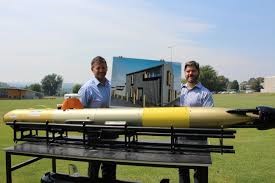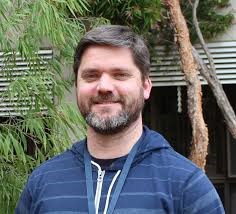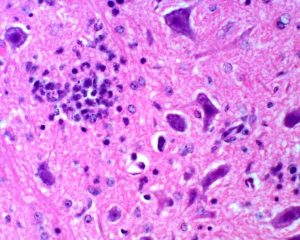 Twenty-seven species are listed as having gone extinct from Tasmania in recent times. Threatened Species Day (7 September) marks the date since the last known thylacine died, in 1936. It’s a time to reflect on why extinction matters to us, and how we might reduce our negative impacts on species survival. My own response, as a threatened species zoologist, has been to take up a Churchill Fellowship on citizen science, to engage the wider community in better understanding the needs of the plants and animals in their own backyards. In this talk, I share my findings on how this might work most effectively. Dr Clare Hawkins carried out her Ph.D. on the fossa (Cryptoprocta ferox), a semi-arboreal mammalian carnivore endemic to the forests of Madagascar. Its ecological similarities to the spotted-tailed quoll (Dasyurus maculatus) brought her to Tasmania in 2001 to study the latter species’ habitat requirements. She subsequently joined the State Government, initially with the Save the Tasmanian Devil Program, and spent four years monitoring the impact and distribution of Devil Facial Tumour Disease. She is currently the IUCN Australasian Marsupial and Monotreme Specialist Group Red List coordinator and author of the Naturetrackers blog. For the Bookend Trust, she co-organised two ‘Extinction Matters’ BioBlitzes in 2016, held on either side of Threatened Species Day, to be reprised this year in November. Her current focus is on novel approaches to better monitor and manage Tasmania’s diverse threatened fauna (from quolls and eagles to skinks, butterflies and burrowing crayfish). In 2015, she was awarded a Gallaugher Bequest Churchill Fellowship to develop citizen science study designs for long term monitoring.
Twenty-seven species are listed as having gone extinct from Tasmania in recent times. Threatened Species Day (7 September) marks the date since the last known thylacine died, in 1936. It’s a time to reflect on why extinction matters to us, and how we might reduce our negative impacts on species survival. My own response, as a threatened species zoologist, has been to take up a Churchill Fellowship on citizen science, to engage the wider community in better understanding the needs of the plants and animals in their own backyards. In this talk, I share my findings on how this might work most effectively. Dr Clare Hawkins carried out her Ph.D. on the fossa (Cryptoprocta ferox), a semi-arboreal mammalian carnivore endemic to the forests of Madagascar. Its ecological similarities to the spotted-tailed quoll (Dasyurus maculatus) brought her to Tasmania in 2001 to study the latter species’ habitat requirements. She subsequently joined the State Government, initially with the Save the Tasmanian Devil Program, and spent four years monitoring the impact and distribution of Devil Facial Tumour Disease. She is currently the IUCN Australasian Marsupial and Monotreme Specialist Group Red List coordinator and author of the Naturetrackers blog. For the Bookend Trust, she co-organised two ‘Extinction Matters’ BioBlitzes in 2016, held on either side of Threatened Species Day, to be reprised this year in November. Her current focus is on novel approaches to better monitor and manage Tasmania’s diverse threatened fauna (from quolls and eagles to skinks, butterflies and burrowing crayfish). In 2015, she was awarded a Gallaugher Bequest Churchill Fellowship to develop citizen science study designs for long term monitoring.
27th November 2016 QVMAG Director Richard Mulvaney ‘The Queen Vic: 125 and still going strong’
1.30 pm Sunday 27th November
 The Queen Victoria Museum and Art Gallery (QVMAG) celebrated its 125th anniversary on 29 April 2016 with an exhibition in the original museum building, now the art gallery, on Wellington Street. Titled The World Inside, the exhibition featured an eclectic assortment of objects arranged very much in the style of a 19th Century museum, with special reference to the longstanding first Director, Herbert Scott. While it opened in 1891 with significant promise, its origins go back to the formation of the Launceston Mechanics Institute in 1842 and the Royal Society (northern branch) in 1853. It was the urgings of these two societies that gave rise to the Queen Vic and who have contributed to it significantly since. Today it is Australia’s largest regional museum and art gallery.
The Queen Victoria Museum and Art Gallery (QVMAG) celebrated its 125th anniversary on 29 April 2016 with an exhibition in the original museum building, now the art gallery, on Wellington Street. Titled The World Inside, the exhibition featured an eclectic assortment of objects arranged very much in the style of a 19th Century museum, with special reference to the longstanding first Director, Herbert Scott. While it opened in 1891 with significant promise, its origins go back to the formation of the Launceston Mechanics Institute in 1842 and the Royal Society (northern branch) in 1853. It was the urgings of these two societies that gave rise to the Queen Vic and who have contributed to it significantly since. Today it is Australia’s largest regional museum and art gallery.
 Richard Mulvaney has been the Director of QVMAG for six years. He completed a Bachelor of Arts (Prehistory/History) at ANU in 1980, a Bachelor of Letters (Prehistory) ANU in 1983 and a Graduate Diploma Museum Studies (Monash) in 1984. He has held several positions in museums across Australia, including the Australian War Memorial, the Australian Institute of Aboriginal Studies, Sovereign Hill, the Bradman Museum, the NSW Rail Heritage Centre and Museums and Galleries NSW. He is currently on the Tasmanian Arts Advisory Board, the Port Arthur Historic Site Conservation committee and is Vice-President of Museums Australia the peak industry body based in Canberra.
Richard Mulvaney has been the Director of QVMAG for six years. He completed a Bachelor of Arts (Prehistory/History) at ANU in 1980, a Bachelor of Letters (Prehistory) ANU in 1983 and a Graduate Diploma Museum Studies (Monash) in 1984. He has held several positions in museums across Australia, including the Australian War Memorial, the Australian Institute of Aboriginal Studies, Sovereign Hill, the Bradman Museum, the NSW Rail Heritage Centre and Museums and Galleries NSW. He is currently on the Tasmanian Arts Advisory Board, the Port Arthur Historic Site Conservation committee and is Vice-President of Museums Australia the peak industry body based in Canberra.
Venue: Meeting Room, QVMAG at Inveresk
Admission: $6 General Public, $4 Friends of the Museum and Students
Free for members of The Royal Society of Tasmania
As these events are popular, RSVP is essential by Thursday 24th November 2016:
Email bookings@qvmag.tas.gov.au or telephone 6323 3798
Genetic Analysis of Australia’s Extinct Fauna, Dr Kieren Mitchell, 25th September, 2016
In the Meeting Room, QVMAG at Inveresk, 1.30 pm Sunday 25th September 2016
Following its death, the DNA of an animal can be preserved in its bones and teeth for thousands of years. Sequencing this “ancient DNA” allows us to gain insights into the identity and evolution of now-extinct species. In this presentation Kieren will discuss the history of the ancient DNA field, factors affecting the preservation of DNA, and work he is currently involved in focused on extinct Australian species such as the thylacine and giant short-faced kangaroos.
Dr Kieren Mitchell grew up in Tasmania before moving to Adelaide for university, where he studied genetics and evolutionary biology. Having completed his PhD, he now works at the Australian Centre for Ancient DNA at the University of Adelaide. He currently collaborates with researchers from around the world to study extinct species from North America, South America, Europe, Asia, New Zealand, Madagascar, and Australia.
Admission: $6 General Public, $4 Friends of the Museum and Students
Free for members of The Royal Society of Tasmania
As these events are popular, RSVP is essential Thursday 22nd
Autonomous Underwater Vehicles in Under-Ice Exploration and Research, Mr Peter King, 28 August, 2016
August 28, 1.30 pm in the Meeting Room, QVMAG, Inveresk
Mr Peter King
Autonomous Underwater Vehicles (AUVs) are free swimming robots, which can travel to great depths and far reaching locations. Beginning in the 70s, researchers have tried to exploit their capabilities for working in one of the most remote environments of the earth, under-ice. With continued development and new technologies AUVs continue increase their vital role in under-ice exploration and polar science. In 2015 the Australian Maritime College, under the Antarctic Gateway Partnership project, committed to the purchase and development of an advanced, polar capable AUV. This talk will outline some history of AUV operations in under-ice exploration, their current role in Antarctica and the engineering challenges they face.

Mr Peter King is the coordinator of the Australian Maritime College’s AUV Facility. Since obtaining his engineering degree from Memorial University of Newfoundland, he has spent over a decade working in ocean technology, research, and autonomous underwater vehicles. At Memorial, he was the lead operator and engineer for a large survey AUV, conducting habitat survey, hydrodynamic studies, and development of vehicle autonomy and advanced navigation. Under the Antarctic Gateway Partnership project, Peter has come to Tasmania to help bring online, a new polar capable AUV for polar research in Antarctica.
Admission: $6 General Public, $4 Friends of the Museum, LHS Members, and Students
Free for members of The Royal Society of Tasmania
To assist us with the organization of this event
RSVP by Thursday 25th August 2016:
Email bookings@qvmag.tas.gov.au or telephone 6323 3798
Professor Nicholas King presents The Enthusiastic Immune System: Curbing Nature’s Oldest Attack Dogs without Forgoing their Protection — Meeting Room, QVMAG at Inveresk — 1.30 pm Sunday 26th June 2016
The Royal Society of Tasmania — 2016 Launceston Lecture Series
Professor Nicholas King
M.B. Ch.B., Ph.D., FRCPA (Hon)
Professor and Head of Immunopathology, Discipline of Pathology, School of Medical Sciences USYD will present
The Enthusiastic Immune System: Curbing Nature’s Oldest Attack Dogs without Forgoing their Protection
in the Meeting Room, QVMAG at Inveresk — 1.30 pm Sunday 26th June 2016

 Once infected by virus, nerve cells of the brain will attract large numbers of white blood cells to clear the infection. Among these, a primitive group known as monocytes, newly minted by the bone marrow, causes inflammation that amplifies the immune response. However, this behaviour can also cause lethal damage. In a novel therapeutic strategy, we have used immune modifying nanoparticles to modulate monocyte migration and function, to reduce inflammation, increase healing and enable survival, not just in viral infection of the brain, but in a range of other diseases in which inflammation is excessive.
Once infected by virus, nerve cells of the brain will attract large numbers of white blood cells to clear the infection. Among these, a primitive group known as monocytes, newly minted by the bone marrow, causes inflammation that amplifies the immune response. However, this behaviour can also cause lethal damage. In a novel therapeutic strategy, we have used immune modifying nanoparticles to modulate monocyte migration and function, to reduce inflammation, increase healing and enable survival, not just in viral infection of the brain, but in a range of other diseases in which inflammation is excessive.
 Prof. Nicholas King, as Professor of Immunopathology, heads the Discipline of Pathology and is Founding Director of the Advanced Cytometry Core Facility at the University of Sydney. He holds both Medical and PhD degrees and runs a research group that investigates how the immune response causes damage during neurotropic mosquito-borne virus infections, publishing widely on the subject over more than 30 years. He has been President of the Federation of Immunological Societies of Asia-Oceania and is currently on the Executive Council of the International Union of Immunological Societies. He holds a Vice Chancellor’s Excellence in Teaching Award and was awarded honorary membership of the Royal College of Pathologists of Australasia.
Prof. Nicholas King, as Professor of Immunopathology, heads the Discipline of Pathology and is Founding Director of the Advanced Cytometry Core Facility at the University of Sydney. He holds both Medical and PhD degrees and runs a research group that investigates how the immune response causes damage during neurotropic mosquito-borne virus infections, publishing widely on the subject over more than 30 years. He has been President of the Federation of Immunological Societies of Asia-Oceania and is currently on the Executive Council of the International Union of Immunological Societies. He holds a Vice Chancellor’s Excellence in Teaching Award and was awarded honorary membership of the Royal College of Pathologists of Australasia.
Admission: $6 General Public, $4 Friends of the Museum and Students
Free for members of The Royal Society of Tasmania
To assist us with the organisation of this event
RSVP by Thursday 23rd June 2016:
Email bookings@qvmag.tas.gov.au or telephone 6323 3798
Delving into the Soil Carbon Black Box – November 24th 2013
Dr Leigh Sparrow, Senior Research Fellow in Soil Science, Tasmanian Institute of Agriculture, UTAS
will present Delving into the Soil Carbon Black Box in the Meeting Room, QVMAG at Inveresk, 2.00 pm Sunday November 24th 2013
Abstract
By virtue of its cool temperate climate, Tasmania’s soils generally have high concentrations of carbon. Intensive farming, especially frequent cropping, causes carbon concentrations to decrease. Dr Sparrow will outline the principles which govern the amount of carbon expected for any particular combination of soil, climate and farming system, and show how these apply to current Tasmanian situations. The data provide cause for concern about sustainable farming and carbon sequestration in soil, but there is also some good news.
Biography
Dr Sparrow is a Senior Research Fellow in Soil Science with the Tasmanian Institute of Agriculture, University of Tasmania. With a background in soil fertility, Dr Sparrow’s early career focused on soil testing and fertiliser management, but he has also studied heavy metal contamination, irrigation management and soil-borne diseases. His recent research includes modelling and measuring changes in soil carbon in different farming systems, with the aim of assessing the capacity of the soil to sustain agriculture. Implications for carbon storage in soil have also been evaluated.
Admission: $5 General Public, $3 Friends of the Museum, $2 Students
Free for members of the Royal Society of Tasmania
To assist us with the organization of this event
RSVP by Thursday 21st November 2013:
Email bookings@qvmag.tas.gov.au or telephone 6323 3798
Science Education in Tasmania – a teacher’s perspective – 22 September, 2013
Science Education in Tasmania – a teacher’s perspective.
Presentation by Jane Hall-Dadson
QVMAG – Inveresk
Sunday 22 September at 2.00 pm
Jane Hall-Dadson Advanced Skills Teacher, Mathematics Learning Area, Launceston College, Tasmania will present
Science Education in Tasmania – a teacher’s perspective.
in the Meeting Room, QVMAG at Inveresk at 2.00 pm Sunday September 22nd 2013
Admission: $5 General Public, $3 Friends of the Museum, $2 Students
Free for members of the Royal Society of Tasmania
To assist us with the organization of this event
RSVP by Thursday 19th September 2013:
Email bookings@qvmag.tas.gov.au or telephone 6323 3798
Good teaching requires a solid curriculum, engaging activities with relevance to real life and passionate, well- trained teachers, Jane Hall-Dadson says.
Ms Hall-Dadson will outline the recent history of changes in Tasmania’s Science curriculum, showing how students learn scientific concepts, develop scientific skills and understand applications of science in the real world citing innovative programs and inspiring student work.
She will also discuss strategies to enhance uptake of Science subjects beyond grade 10 .
Jane Hall-Dadson began her career as a Medical Laboratory Scientist, working in private pathology, mainly in Medical Microbiology and Haematology/Serology. She completed teacher training and became a Secondary Science & Mathematics teacher in 1997.
Her work has been recognised in numerous awards including a series of TSTS ANZAAS Science Teacher Awards, the Australian Academy of Science Teacher Award and the 2010 Australian Museum Eureka Prize for Science Teaching. Ms Hall- Dadson is Vice-president of the Science Teachers Association of Tasmania and represents Tasmania on the Council of the Australian Science Teachers Association.
Fish Health and Seafood (National Science Week special event) – 11 August 2013
The RST Northern Chapter has organized a special event for National Science Week to highlight work currently being carried out by scientists in Tasmania.
Fish Health and Seafood
Fish Health and Seafood will presented by three speakers from the National Centre for Marine Conservation and Resource Sustainability, University of Tasmania, Launceston in the:
Meeting Room, QVMAG at Inveresk at 2pm Sunday 11 August 2013
RSVP bookings@qvmag.tas.gov.au
see attachment below for further details
